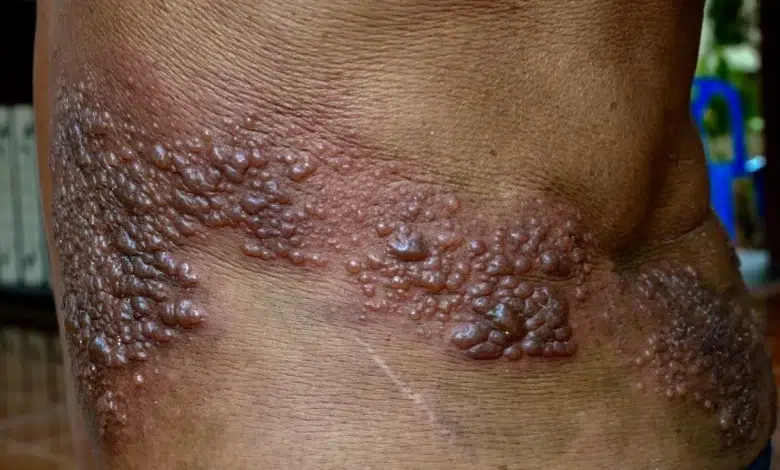Shingles: Recognizing the Symptoms

Shingles, also known as herpes zoster, is a viral infection that causes a painful and distinctive rash. It occurs when the varicella-zoster virus, the same virus responsible for chickenpox, is reactivated in the body years after the initial infection. Recognizing shingles symptoms early is essential for timely treatment and preventing complications. This article explains the common signs and symptoms of shingles to help readers identify the condition promptly.
ALSO READ: No Pills, No Surgery: Groundbreaking Discovery Offers Simple Solution for Arthritis Pain Relief
Table of contents
What Causes Shingles?
After a person recovers from chickenpox, the varicella-zoster virus remains dormant in nerve tissues. It can reactivate later in life, often when the immune system is weakened due to age, stress, illness, or certain medications. This reactivation causes shingles. While anyone who has had chickenpox can develop shingles, it is most common in adults over 50.

Early Symptoms: Signals Before the Rash
Shingles usually begins with sensations localized to one area of the body. Early symptoms often appear 1 to 5 days before the characteristic rash and may include:
- Tingling, burning, numbness, or itching: Patients often feel unusual sensations on a specific patch of skin that will later develop a rash.
- Pain: This can range from mild discomfort to intense, sharp, or stabbing pain and is often the first noticeable symptom. Pain may be mistaken for other conditions like heart or lung problems when located on the chest.
- Flu-like symptoms: Fever, chills, headache, fatigue, and gastrointestinal upset such as nausea may accompany early symptoms.
The Shingles Rash: What to Look For
When the rash develops, it typically appears in a band or strip on one side of the body or face, reflecting the path of affected nerves (dermatomes). Key characteristics include:
- Red or discoloured skin that rapidly develops clusters of small, fluid-filled blisters.
- The rash usually affects the torso, neck, or face but can appear on other parts, including the leg in rare cases.
- Blisters eventually break open, forming crusts or scabs over 7 to 10 days.
- The rash is often painful and sensitive to touch, sometimes making clothing or bedding uncomfortable.
Is Shingles Contagious?
Shingles itself is not contagious, meaning you cannot catch shingles directly from someone who has it. However, the varicella-zoster virus (VZV) that causes shingles can be spread to people who have never had chickenpox or the chickenpox vaccine. This transmission occurs through direct contact with the fluid from the shingles blisters during the blister phase. In such cases, the exposed person would develop chickenpox, not shingles.
Once the rash crusts over, which usually takes 7 to 10 days, the risk of spreading the virus is very low. To prevent transmission:
- Keep the shingles rash covered.
- Avoid touching or scratching the rash.
- Wash your hands frequently.
- Avoid contact with pregnant women who have never had chickenpox or the vaccine, newborns, and people with weakened immune systems.
If you have already had chickenpox, exposure to someone with shingles does not put you at risk of developing shingles.
Additional Symptoms and Complications
Other symptoms that may arise alongside shingles rash include:
- Itching and burning sensations in the affected area.
- Swollen lymph nodes near the rash.
- Sensitivity to light and general malaise.
In some cases, shingles leads to postherpetic neuralgia, where pain persists for months or even years after the rash heals. This can be particularly severe and impact quality of life.
When to Seek Medical Advice
Consult a healthcare professional promptly if you experience:
- Tingling or pain in a limited skin area without an obvious cause, especially if over 50 years old.
- A painful, blistering rash appearing on one side of the body.
- Symptoms involving the face, particularly around the eyes or ears, as this requires urgent treatment to prevent complications.
- Severe pain or symptoms persisting beyond the rash’s healing.
Early antiviral treatment can reduce symptom severity, speed recovery, and lower the risk of complications.
Preventing Shingles
Vaccination against shingles is recommended for older adults and those with weakened immune systems to reduce incidence and severity.
Seek Medical Assistance
Recognizing shingles symptoms early is crucial for seeking timely medical care and reducing the risk of complications such as postherpetic neuralgia. While shingles itself is not directly contagious, the varicella-zoster virus can be transmitted to others who have never had chickenpox, causing them to develop chickenpox instead.
Being aware of the early signs, such as localized pain, tingling, and a characteristic rash, helps ensure prompt treatment with antiviral medication, which can ease symptoms and speed healing. Vaccination remains the most effective preventive measure. Staying informed empowers individuals to protect themselves and their loved ones from the discomfort and potential severity of shingles.




